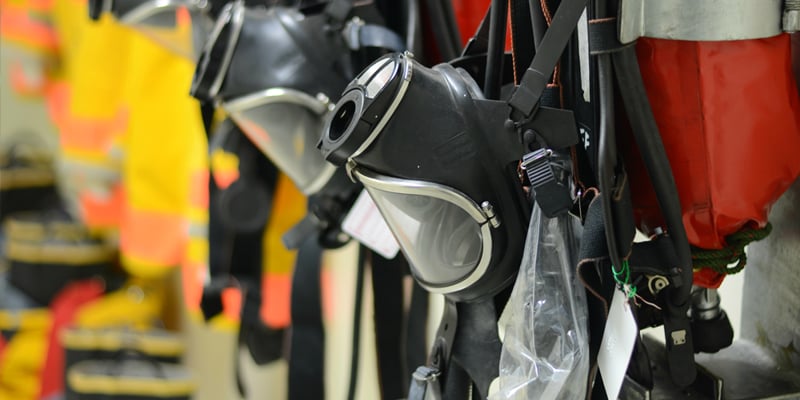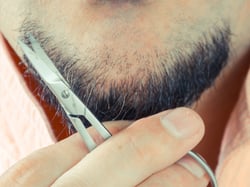
By
Rob Boyle
October 10, 2024
Updated
October 10, 2024

How can I protect myself from chemicals at work?
Whether you work in the office, from home, or in the field, you are working near chemical substances. There are an estimate 650,000 existing hazardous chemical products and counting.
What are the different types of chemicals and how can they affect me?
Common chemical substance types include:
- Toxic – Causes sickness or death
- Corrosive – Causes irritation or burns to the skin or eyes on contact
- Flammable – Easily catches fire
- Reactive – Could explode under certain circumstances
- Radioactive – Causes burns to the skin on contact or in some cases cancer
What are the risks of working with chemicals?
The risks of working with hazardous chemicals are high, as there are many ways they can affect your body. There are four ways that chemicals can cause bodily harm:
- Contact – with skin or eyes
- Ingestion – in food or beverages or smoking materials that become contaminated
- Breathing – inhaling gas substances
- Injection – by cutting or sticking yourself with a contaminated instrument.
How can I work safely with chemicals?
In order to work safely with chemicals, workers must be aware of the chemicals present and the safety guidelines for their use. Manufacturers and importers of chemical products are required to prepare labels and material safety data sheets (MSDS) with hazard information to their customers and to the employers that purchase their products. Taking the time to read these labels could prevent unnecessary accidents.
Here a just a few basic guidelines to follow:
- Make sure that food, cigarettes and street clothing are not left in the work area where they can be contaminated
- Have all the protective equipment you need
- Have access to emergency eyewash kits and emergency showers
What should I do if I am exposed to a chemical?
If an accident occurs and you are overexposed to a chemical, let a supervisor know immediately. Medical attention may be advised. If your chemical exposure was topical, wash your skin with water for at least fifteen minutes. If you have inhaled something, remove yourself to an area with fresh air. Being safety-conscious of the possible chemical hazards in your workplace is the first step to preventing accidents.
What is SCBA and how can it protect from chemicals?
There are many hazardous chemicals in the workplace that can be harmful to the internal body by inhalation. Breathing contaminated and toxic air can be prevented by a Self-Contained Breathing Apparatus or SCBA.
An SCBA provides breathable air carried in a compressed air tank to an individual through a face mask. Each SCBA is different depending on the manufacturer and type, therefore personnel who is well trained on the manufacturer’s manual and instructions is required to inspect and conduct technical repair operations on the unit. Proper storage, maintenance and inspection is crucial to guarantee that the respirator is ready for use. For safety, inspect before and after each use and at least monthly, even if the respirator has not been in use.

How do I find the right SCBA to fit my face?
Anyone wearing a respirator must be fit-tested because respirators will only be effective if there is a tight seal between the face piece and the wearer’s face. Since there are many different face shapes, SCBA manufacturers will offer a number of sizes. The purpose of fit-testing is to find the manufacturer/size combination that offers the best protection. Factors such as beards, weight loss/gain, dentures, dental work, or facial injury can change the shape of the face, which will potentially change the fit and efficiency of the respirator.
Section 1910.134 (e) (5) (i) of the OSHA General Industry Standards states: “Respirators shall not be worn when conditions prevent a good face seal. Such conditions may be growth of beard, sideburns, a skull cap that projects under the facepiece."
Why should I have trim facial hair at work?
 It is important that there is not facial hair between your face and the respirator seal. This would include any tight-fitting, air-purifying respirator.
It is important that there is not facial hair between your face and the respirator seal. This would include any tight-fitting, air-purifying respirator.
Even several days’ beard growth or a heavy stubble can reduce the possibility of a face-to-facepiece seal. Please remember to always follow your work location’s facial hair policy in order to stay compliant and safe.
Asbestos risks
Ensuring workplace safety is paramount, particularly when dealing with hazardous substances like asbestos. Asbestos, known for its durability and heat resistance, can be extremely dangerous when its fibers are inhaled, leading to severe health issues such as lung cancer, epithelioid type of mesothelioma or mesothelioma of the lungs.
To mitigate these risks, workplaces must implement stringent safety protocols, including proper identification, handling, and disposal of asbestos-containing materials.
To minimize exposure, regular employee training, the use of personal protective equipment, and adherence to regulatory guidelines are essential.
By prioritizing these measures, employers can safeguard their workers’ health and maintain a safe working environment.
